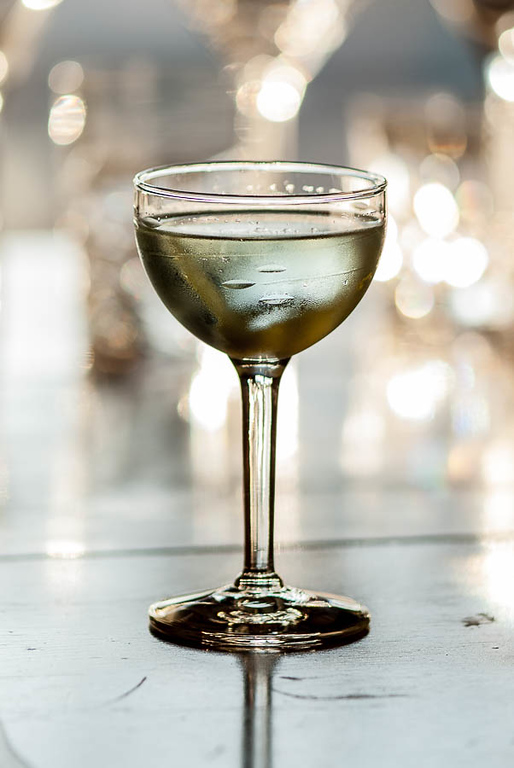The Atty Cocktail is a Martini with embellishments; if you get the proportions right, those embellishments are surprising, flavorful and entertaining.
There is a predecessor to the Atty called the Attention. It’s not a cocktail I would normally write about here—as originally conceived, the Attention is a bad cocktail, one of Hugo Ensslin’s worst (Recipes for Mixed Drinks, 1917). Equal parts gin, vermouth, absinthe, and violette, it is an undrinkable mishmash of flavors.
But that early version of Attention is important to this story because it is almost certainly the inspiration for Harry Craddock’s delightful Atty. First published in Craddock’s Savoy Cocktail Book (1930), the Atty has the same ingredient list as the Attention, but in much more artful proportions. (Craddock lifted much of Ensslin’s earlier work wholesale, but replacing the Attention with his much more drinkable Atty was certainly a moment of genius and restraint for Mr. Craddock, and a win for the Savoy.)
In the Atty we have a classic gin martini with the signal additions of absinthe and Creme de Violette; together, they present a flavor tension that is hard to describe. In a properly balanced Atty, each sip of the cocktail presents alternating sensations of floral sweetness, herbs, and spices—it isn’t an argument exactly, but more a flavor conversation as the cocktail rolls from the lips to the throat, and each component attempts to return to the fore.

History was cruel to Atty, though. You rarely encounter the Atty in mixer’s manuals because for decades it was an unfashionable and irreproducible historic curiosity. When Patrick Duffy added it to his Standard Bartender’s Guide in 1934, he dropped absinthe from the recipe, and other influential manuals (like Trader Vic’s 1947 Bartender’s Guide) followed suit. The surprise and delight of the absinthe and violette combination was gone, and Atty was reduced to nothing more than a florid Martini. Then, like the Aviation and the Blue Moon, the Atty Cocktail fell completely into obscurity, put out of its misery when Creme de Violette disappeared from the market. (I’ve always wanted to call these stranded drinks “zombie cocktails,” but there’s the problem of that very famous rum drink that already used the term…)
Fortunately, with proper absinthe and Creme de Violette available once again, the Atty is back on the active list, and is well worth our attention.
The Atty Cocktail
- 1½ oz London Dry Gin (Bombay Dry, Beefeaters)
- ¾ oz Dry Vermouth (Noilly Prat French Dry)
- ⅛ oz Absinthe (Kübler, Herbsaint)
- ⅛ oz Crème de Violette (R&W)
The lemon is more than a garnish in this cocktail. Garnishes weren’t a strong point for Craddock, and he didn’t list one for the Atty, but that lemon twist enhances the nose and the flavors remarkably. I consider it mandatory.
The vermouth tempers the other flavors, and helps them make sense together. Craddock’s original gin-to-vermouth ratio is 3:1; you may want to try 2:1. Noilly Prat’s herbal French Dry is a good choice here. Increased vermouth brings the violette flavor to the fore; before the Atty, it had never occurred to me that you can balance two strong flavors (absinthe and violette) by adjusting a third bridging ingredient.
Since absinthe overpowers other flavors as it warms, keep the Atty small—2 to 3 ounces—so it will stay very cold as you drink it.
The Savoy lists the absinthe and violette in dashes (3 dashes each.) A standard barspoon is an eighth of an ounce, which seems to be a pretty good substitute for “3 dashes” in my experience. It’s a good starting point; the real measures will depend on the characteristics your absinthe and violette. I have been making Atty with the white Kübler absinthe. I also experimented with Herbsaint; it works, but seems a little harsh compared to the Kübler.
The Rothman and Winter Creme de Violette is a very good choice for the Atty; it matches well with the Kubler at equal portions. I have also used the Bitter Truth Violette; it has a more pleasant and less medicinal nose, but the flavor is lighter, so you’ll need more (or more vermouth) to balance the absinthe properly. (It adds considerably to the sweetness, and it turns the drink very, very blue.)
Note 1: I wondered if the reincarnated Creme Yvette is a good source of the violette for Atty. Not so much. For one thing, the drink turns to that lovely Yvette Pink instead of the opalescent blue that was surely part of the original concept. More to the point, Yvette is not a good flavor match for the absinthe. Perhaps it would go with an absinthe other than the Kubler, but I was not able to adjust the mix pleasurably.
Note 2: Since I started this article dissing the Attention, I should note that, with time, its formula has evolved into something very much like the Atty. The modern Attention has a 4:1 proportion of gin to vermouth and a dash of orange bitters, along the lines of Jamie Boudreau’s recipe at SpiritsAndCocktails.
Note 3: Atty drinkers should probably be aware of the Arsenic and Old Lace Cocktail, which has a resemblance to the Atty, but with the proportions of absinthe and vermouth switched. I still say it’s the vermouth that makes the absinthe and violette a working team; Arsenic and Old Lace pretty much validates that hypothesis.
“A Martini with something in it — the astonishing Atty Cocktail” at cold-glass.com : All text and photos Copyright © 2012 Douglas M. Ford. All rights reserved.

Looks delish…. except I’m afraid of absinthe….lol….
Double the Rothman Violette, and is perfect… for me anyway.
I think the Rothman is an acquired taste. It gets real sweet, real fast for me. Atty must be a delightful color with the extra dose of violette, though.